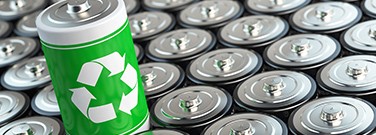Truly Disposable Batteries

By Iva Fedorka
The growth of wearables, packaging, and the rest of the “internet of things” is generating short-lived electronics and increasing concerns about electronic waste. As a result, “sustainable” electronics are attracting significant interest.
Most existing smart devices use standard lithium-ion batteries, alkaline batteries, or other energy-storage methods. However, they contain non-renewable and toxic materials that require special collection and recycling. These standardized batteries have limited use with new, unique smart devices.
A Swiss Sandwich
Made from four layers of 3D-printed material and a gelatinous “ink,” the functioning supercapacitor developed at Empa can power a small digital clock and store electricity for hundreds of hours. It withstands thousands of charge/discharge cycles, is resistant to pressure and shock, and can survive years even in freezing temperatures. And, when it’s no longer needed, it will disintegrate on a compost pile within two months.
"It sounds quite simple, but it wasn't at all," said Xavier Aeby of the Cellulose & Wood Materials lab at the Swiss Federal Laboratories for Materials Science and Technology (Empa). “It took an extended series of tests until all the parameters were right, until all the components flowed reliably from the printer and the capacitor worked.” Said Aeby: "As researchers, we don't want to just fiddle about, we also want to understand what's happening inside our materials."
Aeby’s supervisor Gustav Nyström and his team have been investigating nanocellulose gels for some time. The material is environmentally friendly, renewable, and versatile. "The project of a biodegradable electricity storage system has been close to my heart for a long time," Nyström said. "Now we have achieved our first goal."
Recyclability at Duke
Engineers at Duke University have also developed a fully recyclable printed transistor using three carbon-based inks. Their work appears in the April 26 online version of the journal Nature Electronics.
Insulating cellulose is printed onto other carbon-based components to produce a completely recyclable and fully functional transistor that can be printed onto paper or other flexible surfaces. Carbon nanotubes are used for the semiconductors and graphene inks for the conductors. Recyclability comes from a wood-derived insulating dielectric ink called nanocellulose.
Created using an aerosol jet printer at room temperature, the all-carbon transistors perform well even six months later. The team also submerged the devices in a series of baths, vibrated them with sound waves, centrifuged the solutions, and recovered nearly all of the carbon nanotubes and graphene. Those materials were effectively reused and the nanocellulose recycled along with the paper base.
Potential Advantages
As people buy more electronics, the pile of discarded devices grows. Electronic waste is projected to reach 27 billion units in 2021 and the United Nations estimates that less than a quarter of electronics are currently recycled. Although the copper, aluminum, and steel in these items can be recycled, their silicon chips cannot.
"Recyclable electronics like this aren't going to go out and replace an entire half-trillion-dollar industry by any means, and we're certainly nowhere near printing recyclable computer processors," said Aaron Franklin, the Addy Professor of Electrical and Computer Engineering at Duke University. "But demonstrating these types of new materials and their functionality is hopefully a stepping-stone in the right direction for a new type of electronics lifecycle."
Discussion Questions
- How does a transistor work?
- What is a supercapacitor?
Vocabulary
- Cellulose
- Graphene
- Nanotubes